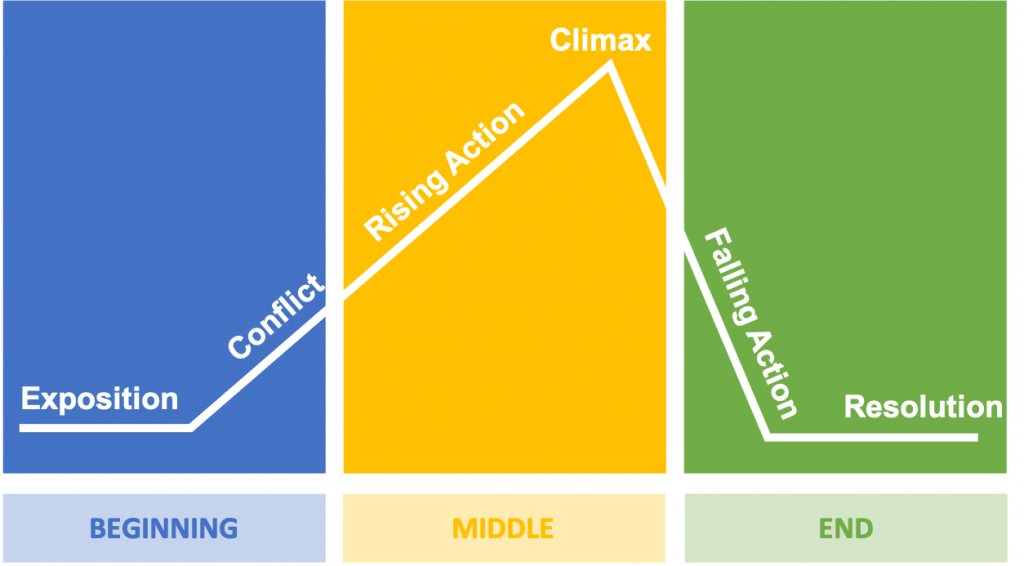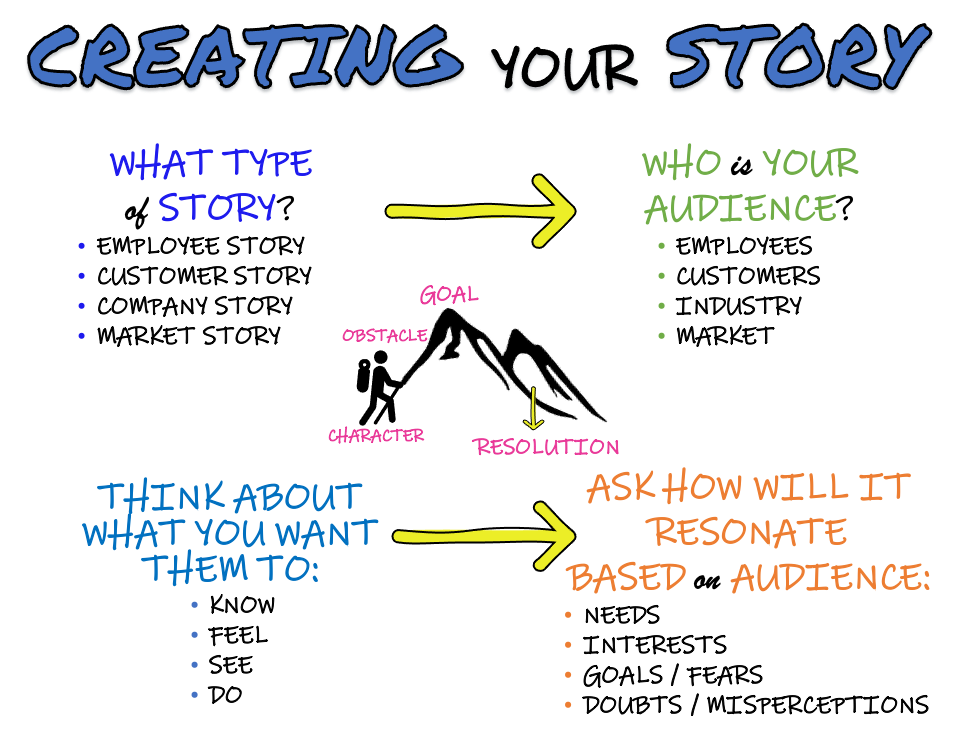1.2 Fundamentals of Storytelling
Learning Objectives
By the end of this chapter, you should be able to:
- Describe the influence Indigenous storytelling has had on storytelling
- Explain the fundamental structure of telling stories
- List key storytelling techniques and questions to answer

Storytelling
A core skill for any digital marketer is the ability to tell compelling stories. As a result, storytelling is a critical element of any digital marketing strategy. So, let’s explore storytelling. When learning something new, we often look to the masters for insights, inspiration, and guidance and when it comes to storytelling, Indigenous Peoples across the world have been and continue to be master storytellers!
Indigenous Peoples are distinct social and cultural groups that share collective ancestral ties to the lands and natural resources where they live, occupy, or from which they have been displaced. The land and natural resources on which they depend are inextricably linked to their identities, cultures, livelihoods, as well as their physical and spiritual well-being. Many Indigenous peoples still maintain a language distinct from the official language or languages of the country or region in which they reside. According to World Bank, there are currently approximately 476 million Indigenous Peoples worldwide, in over 90 countries. As a result, Indigenous Peoples and their stories span the entire globe and most of us are connected, at the very least ancestrally, to these precious societies and cultures.
Throughout history, Indigenous societies have relied on stories to share and pass down their histories, lessons, historical records, and other knowledge to maintain and sustain their cultures and identities. These Indigenous stories reflect the perceptions, relationships, beliefs and attitudes of the Indigenous Peoples and form the foundation of many Indigenous societies. While some may view these stories as peripheral, even in business today, we see the powerful influence of Indigenous storytelling in how marketers share stories with target audiences, convey historical information about their organizations, highlight “organizational identities and cultures”, and build communal experiences. Given this extensive history and expertise in Indigenous storytelling, we can learn a lot from these talented Indigenous storytellers who have been sharing and honing the art of storytelling for millennia.
From First Nations Indigenous storytellers, we learn that their Indigenous storytelling involves:
- Expert use of the voice
- Vocal and body expression
- Intonation
- The use of verbal imagery
- Facial animation
- Context
- Plot and character development
- Natural pacing of the telling, and
- Careful authentic recall of the story
So, how can we apply these indigenous storytelling techniques to our own organizational stories?
Tone and Brand Voice
What tone and voice resonates best with your target audience? Are you using the language and words that they use? While many marketers focus on the message and what they want to communicate, it is equally important to spend time thinking about the tone, language, dialog, and voice being used to communicate.
Tone Example
Consider the following lines from business emails. How would you describe the tone of each entry? What words, phrases, or other elements suggest that tone?
- “Maybe if the project leader had set a reasonable schedule from the beginning, we wouldn’t be in this mess now.”
- “Whatever they’re paying you, it isn’t enough. Thanks for working so hard on this.”
- “I’m not sure what else is on your plate right now, but I need these numbers by this afternoon—actually in the next two hours.”
- “I cant remember when u said this was due.”
- “While I appreciate that your team is being pulled in a number of different directions right now, this project is my department’s main priority for the semester. What can we do from our end to set your group up to complete this by June?
Whether in a workplace or in our personal lives, most of us have received communications that we’ve found off-putting, inappropriate, or, at a minimum, curt. Striking the right tone and being diplomatic, particularly in business communication, can mean the difference between offending your reader and building important relationships. And more immediately, it can mean the difference between getting what you want and being ignored.
As with any piece of writing, considering audience, purpose, and type of information is key to constructing your communication. Truly finessing your writing so that it works for you, rather than against you, is key to forming strong relationships and being effective.
Attribution: The above material is taken from Diplomacy, Tone, and Emphasis in Business Writing in the Writing Commons and is used under a CC-BY-NC-ND 3.0 Unported license.
Consider these questions related to tone and voice:
- What is my intent? Am I trying to inform or to persuade?
- What tone and voice is most appropriate for the target audience?
- Are the tone and voice respectful?
- How can the content be presented so it is informative and persuasive but not condescending?
- What words demonstrate sensitivity to the audience’s views and feelings?
- Have any insensitive words or examples been presented that are likely to cause offence to the readers or viewers?
Imagery
Imagery is not just visual. Building on the previous point, there is visual imagery and verbal imagery. Visual imagery describes what we see and is what we traditional think about when we think of imagery, e.g., photographs, charts, icons, etc. Verbal imagery represents the words and sounds one uses to paint a clear picture in your audience’s minds. In many ways, verbal imagery can trigger stronger memories or emotions by connecting key words and sounds to important concepts, ideas, feelings, and yes, even brands. This is why jingles can be so effective in branding activities.
Verbal Imagery Example
Verbal imagery often requires providing additional details to support the specific situation being shared. While many may think verbal imagery describes the visual context using words, here is a simple example:
- First Pass: “Sam is a jerk.”
We all know jerks, but why is Sam a jerk?
- Second Pass: “Sam’s a jerk because they were mean to the barista preparing their coffee.”
We now have a clearer picture in our minds. Sam’s standing in a coffee shop and they are clearly not happy. But again, why is Sam unhappy?
- Third Pass: “Sam’s a jerk who is giving this unsuspecting barista a hard time because they are mad at their partner for making them drop their 5-year-old off at daycare before heading to work.”
We now have a much clearer impression of what Sam’s morning has been like and why Sam is unhappy.
Facial Animation
As more marketers explore videos and images, what facial expressions and animations are you including? The facial expressions shared can have a significant impact on your viewers. Are the people in your video smiling or frowning? Are they excited or indifferent? Are they puzzled or enlightened? And remember that even when writing a story, think about the words you are using (verbal imagery) to describe that facial expression and/or animation in your story.
Facial Animation Example
Happy and sad facial expressions may be easy to tell in many images. But what about more subtle expressions? Which emotion is being shown in the following photo?
Young woman sitting alone on a couch (Photo by jcomp on freepik.com)
Is this young woman sad, depressed, reflecting, thinking, or something else? Depending on how this photo is used, it could be interpreted in many different ways. Which brings us to our next point, the importance of context.
Context (or Setting)
All stories require context. Context orients us in place and time. Context tells the audience what the presented information means to them and why they should care. But be careful about just providing facts. Great marketers and storytellers provide rich context. Rich context goes beyond merely sharing what is the context and explores why this context is important or how this context might be applicable to even further-reaching circumstances. Rich context has multiple layers allowing it to resonate with a wider range of audiences. As we saw in the earlier verbal imagery example with “Sam”, adding more context allows the reader or viewer to better relate to what is being shared.
Plot and Character Development
Every story must have a beginning, middle, and end. The following image, also known as Freytag’s Pyramid, is a commonly used framework when developing stories. Please note that this approach can be used for any length of story – short or long.

Freytag’ Pyramid
-
- Exposition
Exposition is the beginning of your story that introduces the 3 Cs: conflict (key issue / problem), characters (customers, perhaps?!), and the context.
- Exposition
-
- Rising Actions
Rising actions present the events before the climax, where your characters attempt to solve the problem (conflict) but fail.
- Rising Actions
-
- Climax
The climax represents the turning point or point of greatest suspense / action in your story.
- Climax
-
- Falling Actions
Falling Actions are the actions and events that happen after the climax.
- Falling Actions
-
- Resolution
End of the story where the conflicts or problems are solved.
- Resolution
When you are telling your organizational stories, are you clearly including all of these elements? And are you walking your audiences through this entire storytelling journey?
Natural Pacing of the Telling
You need to spend time building your story by setting the foundational pieces in the beginning and middle of your story. Getting to your resolution too quickly can undermine the journey and steps required to get to that point. Take the appropriate time to build your story so that your climax truly presents a turning point in the audiences’ journey.
Careful Authentic Recall of the Story
The best stories are those that are authentic, truthful, and clearly present the issues (conflict) and resolution. While many marketers may try to embellish their stories, stick to the facts and let the story tell the compelling narrative. If you feel the story needs to be embellished to make it more captivating, you may not have a story worth sharing.
Most of us heard Indigenous stories as children. (Remember that Indigenous Peoples and their stories span the entire globe; there are Indigenous Peoples of Africa, North America, South America, Asia, Australia, Europe, etc.) What made those Indigenous stories so impactful and how did those stories embody many of the best practices listed above?
As you can see, Indigenous storytelling’s guidance and characteristics still apply today. It is why these stories have spanned millennia and continued to be shared. As marketers, we can learn how to best share compelling stories, as well as how to build and support engaged communities from these impressive Indigenous storytellers. And, as you begin to create your own organizational stories, think about the following questions:
- What kind of story are you creating?
- employee story
- customer story
- organizational story
- market or industry story
- Who is your audience?
(This should align with the kind of story you are creating.)- employees
- customers (potential and/or existing)
- industry
- market
- What do you want your audience to:
- know
- feel
- see
- do
- How will it resonate with your audience’s:
(This should align with what you want your target audience’s responses to be.)- needs
- interests
- goals / fears
- doubts / misconceptions
And, don’t forget that the core of your story should be based on the foundational principles and structure highlighted in Freytag’s pyramid.
Key Takeaways
Telling compelling stories is part art and part science. When told well, stories can have a tremendous impact and influence on your audience. Here are some of the key takeaways in creating engaging and memorable stories:
- Indigenous storytellers are the masters. From them, marketers can learn how to tell compelling, engaging, and memorable stories. Some of the key Indigenous storytelling elements to include and consider are:
- Expert use of the voice
- Vocal and body expression
- Intonation
- The use of verbal imagery
- Facial animation
- Context
- Plot and character development
- Natural pacing of the telling, and
- Careful authentic recall of the story
- Every story should have a beginning, middle, and end. And, each story should have challenges (conflict), goals (climax), and context.
- Great stories incorporate tone, voice, imagery, facial expressions, plot and character development, pacing, and authentic recall.
- When creating stories think about:
- the kind of story you are creating,
- who is in your audience,
- what you want your audience to know, feel, see, and do, and
- how your story will resonate with your audience’s needs, interests, goals, fears, doubts, and misconceptions.
Storytelling Exercises
Below are a few exercises to apply and explore how stories are told:
- Share one of your favourite stories, e.g., a book, article, fairytale, legend, video game, movie, etc.
- Discuss the differences in how stories are told depending on the media, e.g., newspaper, magazines, TV, online articles, podcasts, short videos (like Instagram), movies, video games, etc.
- Hold a story-writing contest. You can keep the competition open-ended or suggest a starting point. For example, maybe start off with a place, an object, a person or creature, and a year. Also, allow the stories to be told using a variety of media types.



